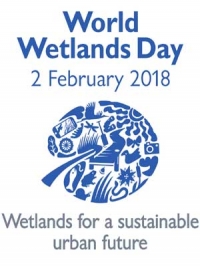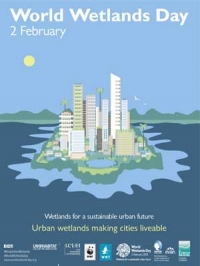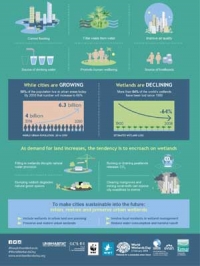World Wetlands Day: Wetlands For A Sustainable Urban Future

World Wetlands Day is observed on 2nd February every year to raise global awareness about the value of wetlands for humanity and the planet. It also marks the signing of the Ramsar Convention on Wetlands, an intergovernmental treaty that provides the framework for international cooperation for the conservation and wise use of wetlands and their resources. The Ramsar Convention on Wetlands was adopted at the Iranian city of Ramsar in 1971, and the World Wetlands Day was celebrated for the first time in 1997.
The theme for World Wetlands Day 2018 is ‘Wetlands for a Sustainable Urban Future,’ and aims to raise awareness about how urban wetlands contribute to the future of sustainable cities. Wetlands are land areas that are flooded with water, either seasonally or permanently. Urban wetlands are found in and around cities or their suburbs and include rivers, flood plains, lakes, and swamps as well as coastal areas like salt marshes, mangroves and coral reefs.
Urbanization is one of the key defining features of modern human civilization and it is completely transforming where and how people will live in the future. Half of humanity, or about 4 billion people live in urban areas today. By 2050 that proportion will reach 66% as people move to cities in search of jobs and a vibrant social life. Cities account for around 80% of global economic output and as they expand, the demand for land increases.
As the demand for land increases, the tendency is to encroach on wetlands. Urban wetlands make cities livable by providing various services, but most people are unaware of their value and importance. They are often viewed as wasteland, available to dump waste or be converted for other purposes. Scientists estimate that at least 64% of the world’s wetlands have disappeared since 1900, while cities have exploded in growth. Yet, when preserved and sustainably used, urban wetlands provide cities with multiple economic, social and cultural benefits. They reduce flooding, replenish drinking water, filter waste, provide urban green spaces, and are a source of livelihoods and human wellbeing.
During storms, urban wetlands absorb excess rainfall, which reduces flooding in cities and prevents disasters and minimizes costs. Wetlands are like giant sponges that absorb excess waters; rivers, ponds, lakes and marshes soak up and store heavy rainfall. In coastal cities, saltmarshes and mangroves work as a buffer against storm surges. During the 2012 Hurricane Sandy, it is estimated that wetlands averted around 625 million USD in property damage in the east coast of the US. Following a devastating season of tropical storms and flood surge in the Caribbean, the USA and Bangladesh during 2017, there has been a global recognition of the vital role of urban wetlands.
Wetlands filter the water that seeps into aquifers, helping to replenish this important water source. Protecting rivers and limiting harmful run-off also helps safeguard the water supply. Additionally, the silt-rich soil and abundant plants in wetlands function as water filters, which absorb some harmful toxins, agricultural pesticides and industrial waste. Urban wetlands also help treat sewage from households as the abundant vegetation act as filters for domestic and industrial waste, contributing to improved water quality.
Urban wetlands also promote human well-being as these preserved green spaces in cities, wetlands offer residents a space for recreation and access to diversity of plant and animal life. Studies confirm that interacting with nature reduces stress and improves our health. Wetlands also improve urban air quality as they radiate moist air thanks to their high water-levels and lush plant life. This naturally cools the air in the local surroundings; a relief both in tropical cities and in extremely dry climates.
Wetlands are also popular fishing grounds, and a source of pleasure and livelihood to many. Reeds and grasses for weaving, native vegetation including medicinal plants and fruits, and tourism are other benefits accrued from urban wetlands. In the history of human civilization, the first cities developed in the fertile wetland floodplains of the Tigris and Euphrates rivers where early settlers could practice agriculture, access water and transport their goods.
Wetlands are vital for human survival and are among the world’s most productive environments. Urban wetlands are indispensable for the innumerable ecosystem services that they provide, including climate change mitigation. There are already successful examples of cities that have committed to sustainably use their wetlands and hopefully, these pioneer cities will serve as a catalyst and inspire deliberate actions that set us on a pathway towards sustainable urbanization.



Rituraj Phukan
Videos
Videos
Videos
@ignitingmindsmagazine
@IgnitingMindsin
Top Stories
- Dedicated to the Sparrows, Forests and Water
- The United Nations Decade of Ecosystem Restoration
- How technology in agribusiness affects climate change, a concrete solution.
- Restless Youth Seek Climate Action
- Telangana Jagruthi International Youth Leadership Conference 18,19,20th January 2019
- Sports for Climate Action Framework launched at COP24
- COP24: One Week of Misgivings
Videos
Businesses
- Can Home Remedies Increase Your Height.
- Success Comes When We Make Innovation a Habit
- Do You Want to Be a Green Entrepreneur?
- Igniting Minds Official Web Portal Launched in New Delhi.
- Strive To Drive The Life
- Do Mobile Apps Facilitate Small Businessmen?
- Water Conservation, Preservation and Restoration. A Global Engineering Challenge.